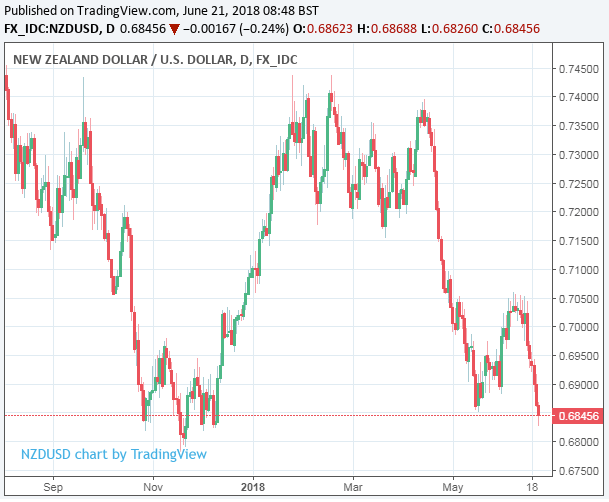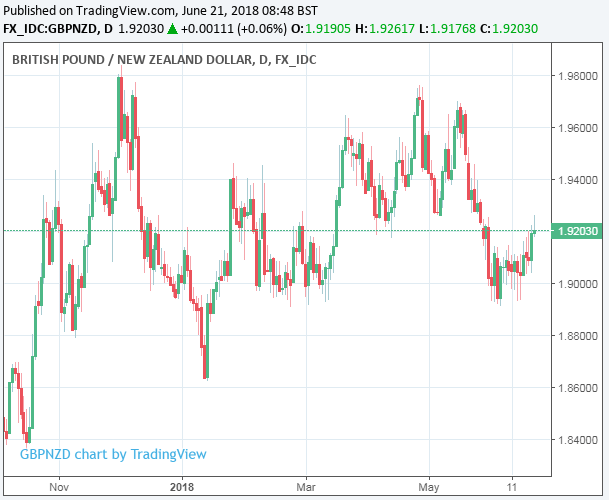New Zealand Dollar Extends Losses after Economic Slowdown Seeps into First-quarter of 2018
- Written by: James Skinner
-
-NZD falls after GDP data shows economy slowing in first-quarter.
-NZ GDP grows 0.5% in Q1, down from 0.6%, and by 2.7% annually.
-Data cement RBNZ's "on hold" stance, dealing another blow to NZD.

© Pavel Ignatov, Adobe Stock
The New Zealand Dollar fell Thursday as financial markets responded to official data showing Kiwi economic growth slowing during the first quarter, which has been seen cementing the Reserve Bank of New Zealand's "on hold" interest rate stance.
Statistics New Zealand data showed the economy growing by 0.5% during the first three months of the year, which is down from 0.6% in the final three months of 2017 but in line with market expectations. GDP per head was unchanged in the opening quarter after growing by 0.1% at the end of 2017.
This took the annual rate of growth down to 2.7%, from 2.9% previously, marking a continuation of a two-year trend toward a softer economic expansion. However, the first-quarter slowdown is not something that was confined to New Zealand as most developed world economies also saw a loss of momentum during the period.
Kiwi services industries made the greatest contributors to the first-quarter result, while output from "goods producing" industries stalled as a contraction in construction activity offset an increase in manufacturing. Household spending was unchanged during the period which, marking the first quarter that Kiwi consumer spending has not grown since 2012.
"Today’s outturn was a respectable print, but economic momentum continues to slow," says Liz Kendall, a senior economist at Australia and New Zealand Banking Group. "Businesses are facing credit and capacity constraints, along with policy uncertainty and margin pressure in the face of rising costs – and these headwinds are flowing through to activity. Encouragingly, businesses are investing. But consumption growth has moderated."
Currency markets care about GDP data because rising or falling demand in an economy has a direct bearing on inflation and it's inflation that central banks are attempting to manipulate when they change interest rates. And interest rates themselves are the raison d'être for most moves in exchange rates.
Changes in interest rates, or hints of them being in the cards, are only made in response to movements in inflation but impact currencies because of the push and pull influence they have on international capital flows and their allure for short-term speculators.
"It is fair to say that downside risks to the outlook have increased a little of late. And with the economy expected to grow around trend, this is of particular relevance for the RBNZ. The outlook for core inflation is by no means assured and resource pressures look set to meander at current levels. We expect that inflation will emerge in time, but very gradually," Kendall adds.

Above: NZD/USD rate shown at daily intervals.
The NZD/USD rate was quoted 0.42% lower at 0.6837 at the London open Wednesday while the Pound-to-New-Zealand-Dollar rerate was 0.22% higher at 1.9220.

Above: Pound-to-New-Zealand-Dollar rate shown at daily intervals.
Economic growth slowed to 2.9% in New Zealand during 2017, down from 4% in 2016, and is forecast by economists to have slowed further during 2018. This, and persistent weakness in inflation, have kept the Reserve Bank of New Zealand from raising its interest rate from the current record low of 1.75%.
This anticipated slowdown in growth for 2018 is seen cementing the RBNZ into its "on hold" stance until well into the 2019 year at the least. Pricing in overnight-index-swaps markets implies a March 21, 2019 cash rate of just 1.81%, suggesting little more than a 20% probability the RBNZ will have raised interest rates by then.
"We believe that the RBNZ will be looking to see a sustained increase in core inflation before an interest rate increase will be on the table. In the current climate, interest rates will remain on hold for some time yet," Kendall writes, in a review of the data.
New Zealand's Dollar had seen a strong start to the year when it rose by more than 5% over the US Dollar during the eight weeks to the end of February however, this increasingly downbeat outlook for monetary policy has driven the Kiwi down by 7% against the Dollar since late April, making for an almost bottom-of-the-league performance.
Headwinds for the Kiwi have been made worse by rising US interest rates that have forced American bond yields higher and shocked the US Dollar back into life. New Zealand's 10 year Treasury yield has fallen precipitously in 2018 while the US 10 year Treasury yield has risen to multi-year highs above the 3.1% level.
This means that investors are incentivised to sell Kiwi Dollars and to buy the greenback in order to invest in the American bond market rather than vice versa. This is the opposite of how the so called carry trade, which has traditionally propped up the Kiwi relative to its international peers, used to work.
"The excessive NZD longs at the end of April, driven in part by an uptick in consumer confidence and spending into the end of Q1, have corrected as data trends have retreated and global macro confidence was undermined by global trade tensions. However, with the dairy price index registering a solid uptrend and long end spreads versus the US rebounding from levels not seen in 25 years, we expect a gradual appreciation in NZD heading into 2019," says Patrick Bennett, a macro strategist at CIBC Capital Markets.
Advertisement
Get up to 5% more foreign exchange by using a specialist provider to get closer to the real market rate and avoid the gaping spreads charged by your bank when providing currency. Learn more here




